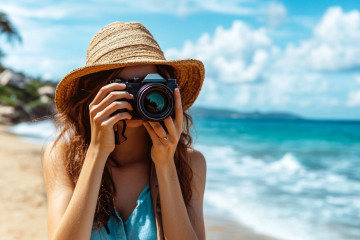We all have locations that make our heart sing when we shoot.
For me, that location is the beach.
It’s where I’m the happiest and feel the most creative and connected. Since I live about an hour away from the beach I don’t get to shoot there often, so I have to make good use of my time and surroundings when I’m there.
Here are a few tips to help you this summer when you hit the beach in search of the perfect shot!
1. Different lighting conditions
When you shoot at the beach often times it seems as though the days are longer, this is because there typically is not much that is blocking the rays from the sun, so the golden hours actually seem to start earlier and end later so keep this in mind if you prefer to shoot in those magical hours where the light is soft and dreamy.
Sunrises and sunsets on the beach can provide some seriously amazing color in your images!
2. Water Reflects Light.
Since light is easily bounced with water you’ll have to keep in mind that when the light is harsher that this will also be reflected in the water and can bounce the light to create unflattering highlights both on your subject and the surroundings.
3. Creative locations
Just because you are shooting at the beach doesn’t mean that you are only limited to the beach! Look for unique settings that will help to tell the story more elaborately.
For example, there is a path that I love to shoot that leads up to the beach. I really enjoy photographing children as they run through it going to the beach, it makes for nice framing and it tells more of the story.
Some other fun ideas might include sand dunes, piers, fun colored beach houses, jetties, lifeguard stands, etc. Don’t be afraid to try out new things, but remember to be careful if you are on piers and jetties!
4. Don’t forget your lens hood
This is especially important on the beach when you are shooting into the sun for backlit images. By using a lens hood you will be able to drastically cut back on haze that could overwhelm your subject.
While I’m all for some yummy haze, I think it’s best in moderation so that it isn’t overbearing. Your lens hood will help you to retain those important details of your subject.
5. Experiment
Shooting at the beach can be a great time to rent a wide angle or a fish eye or even a Lensbaby. These lenses can help to give your images a unique feel and with such a vast and beautiful backdrop what better time to try something new!?
Some other fun and unique equipment you might want to try are Polarizing and UV filters, these can add blues and rich hues to your images while shooting at the beach.
6. Bracketing
When you are shooting at the beach and you are wanting to retain some of the sky along with keeping your subject well exposed and you do not want to use a flash, you can try bracketing!
You can either do this manually by exposing for the different highlights and then shadows or some camera bodies actually have a bracketing mode that will shoot several exposures of the same image. Then you can use your post processing software like Photoshop to merge the images for some very dramatic results.
7. Spot metering
I have always found that spot metering seems to work the best when metering on the beach. This way you are exposing for your subjects skin as opposed to evaluative or matrix metering which might be thrown off by the much brighter background and reflective water.
8. Don’t be afraid of less than ideal weather
One morning I had a session and when I showed up there was so much fog I could hardly see the water. After it started lifting a teeny bit, I was able to start shooting and the fog left me with some very ethereal photos.
The fog also helped to keep the sun from becoming too bright too quickly so I actually had more wiggle room with my time too! Also, stormy dramatic skies can make for some truly stunning images, so don’t fear the clouds if they start to roll in.
9. Watch that horizon
It can be so much more evident when you have a very sharp horizon, like where the ocean meets the sky running through someone’s head or neck. Horizons can also become more sloped and angled if you tend to shoot like a drunk monkey… which I do, so I am always keeping this in mind when shooting.
10. Random strangers
In most cases, you are not going to be the only one on the beach when you are shooting. First thing in the morning joggers and surfers are usually out in full force and by the evening hours families are enjoying walks along the shore.
Try to find a location that might not be as popular, something off the beaten path or just be sure that you are aware of random people that might be popping into your frame and try to shoot around them or angle so that they are not in the photo.
11. Keep an eye on your gear
It is very easy for sand to get into your camera when you are switching lenses especially if you only shoot with primes, like I do. I typically try to change lenses with the body in my bag keeping the sand from blowing in and I do this very quickly.
Also it is very easy to be caught up in the moment and drop your gear into the ocean, so try to always use a strap when shooting in the water.
12. Check your background
Often times on the beach you will find trash cans, over abundance of seaweed, cars and more. Remember to keep an eye on your background to keep distracting elements out of the frame. Having such a wide open space like the beach will just make these elements appear more obnoxious.
13. Safety first
While I am all for trying some creative and fun poses, I always keep safety a top priority when at the beach. It is very easy to slip and fall on slimy rocks that make a jetty or to have a toddler fall face first into the water.
Be mindful of your surroundings and keep safety a top priority when you are shooting at the beach.
14. Have fun
Shooting at the beach can be a ton of fun, especially with children.
Many times they are so interested in exploring their surroundings, don’t become irritated if they don’t want to sit perfectly still and smile at the camera, instead follow them around and try documenting them as they explore their surroundings and feel the salty water or gritty sand between their toes!


